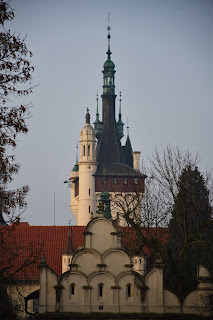Not All Turtles Are Alike
On my
second full day in Xiamen, Kelly, Yiding, and I visited the South Putuo Temple,
originally built during the Tang Dynasty, destroyed during the Ming Dynasty,
and rebuilt during the Qing Dynasty. Before plunging into the hordes of
tourists, we took a little stroll around the pond in front to look at fish and
turtles. To our consternation, we found a monstrous giant turtle in the midst
of the pond’s other inhabitants – likely a rather ill-considered release by a
rogue animal lover.
The people
who released the huge turtle into the pond were not the only people to make a
huge mistake at the South Putuo Temple. After walking through the temple and
taking in its sights, we happened upon a pathway leading up a hill behind it.
Many people were climbing up and down, so we figured we might as well try it
out for a few paces and then return. However, though we clambered and
clambered, the view of the surrounding area became only marginally better,
nudging us on. We happened upon a collection of hundreds and hundreds of small,
either broken or run-down religious statues in a cave of sorts, only partly
protected from the elements. It looked like a dignified dump for holy objects
that people were too afraid to throw away.
Pagoda at South Putuo Temple
Front view of the pagoda
Elephant statue at the entrance to South Putuo Temple
The inner courtyard of South Putuo Temple
A pagoda inside South Putuo Temple
Upper courtyard of South Putuo Temple
Pathway up the hill
View from the hill, with South Putuo Temple in the bottom right corner
A weathered rock
Blue-tailed skink lizard
A grave of a local priest in the likeness of a stupa
Planning our next steps
At some
point – and much later than we should have – we resolved to let the cost sink
and climbed back down again without reaching whatever was at the highest point
(the entrance to the botanical garden, we were told). Kelly wanted to take me
to Xiamen University, once a haunt of the famous Chinese author Lu Xun, yet
upon our arrival at the gate, we were told that visits were only by
reservation. Kelly had taken her mum’s alumna ID in case we ran into a
situation like this, but for whatever reason, the guard chose to disbelieve
that Kelly was truly the daughter of the person on the ID and asked for her
mother’s national identification card, which Kelly obviously did not have.
After
unsuccessfully trying to call a cab using a mobile application – a long story
of Kelly getting increasingly frustrated with a very obtuse lost driver over the
phone – we hailed a taxi off the street and went to eat some dim sum. Yiding
bought a whole plate of chicken feet, which, given the tastes of the rest of
the party, he had to finish all by himself.
Our last
activity of the day was walking along Zhongshan pedestrian road, a locale known
for its Western-style buildings and shops. By pure luck, we walked into a side
road and happened across a protestant church built in the 1840s, in other words
right after the First Opium War and Xiamen’s designation as a Treaty Port. In
the evening, Kelly’s parents made us a giant dinner of many dishes. There was
no way we could finish, but Kelly’s uncle and Yiding came to help consume some
of the drink I would have felt guilty to leave.
More of Xiamen's Art Deco
Zhongshan road
European-style buildings at Zhongshan
More Art Deco
Driving down Zhongshan Road
Another view of Zhongshan Road
A surprising presence among the European-style buildings of Xiamen
The roof of Xinjie Church
A blue dog reading a book - yes, I do not understand either.























Comments
Post a Comment